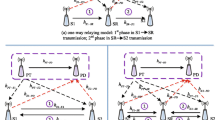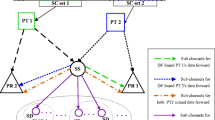Abstract
In this paper, we propose an adaptive spectrum access protocol for secondary users (SUs) be used to access licensed bands in cognitive radio networks. Specifically, if the primary network, which uses multicast communication to transmit data from one primary source to multiple primary destinations, satisfies a required system quality of service (QoS), SUs can access the licensed bands, follows an underlay spectrum sharing. Otherwise, a secondary base (SB) station must assist the primary network in obtaining the QoS so that it can find opportunities to use the bands, i.e., cooperation-based spectrum access. To enhance the performance for the secondary network, in terms of outage probability (OP), various best-user selection methods are proposed. Moreover, we take into consideration the impact of hardware impairments on the OP of both primary and secondary networks. We derive exact and asymptotic closed-form expressions of the OP over Rayleigh fading channel. From the analytical results, an optimal value of maximal interference threshold and an optimal fraction of the SBs’ transmit power to the primary data are obtained when the secondary network operates on the underlay and the cooperation-based spectrum access modes, respectively. Finally, Monte Carlo simulations are performed to verify the theoretical derivations.






Similar content being viewed by others
References
Mitola, J., & Maguire, G. (1999). Cognitive radio: Making software radios more personal. IEEE Personal Communications, 6(4), 13–18.
Goldsmith, A., Jafar, S., Maric, I., & Srinivasa, S. (2009). Breaking spectrum gridlock with cognitive radios: An information theoretic perspective. Proceedings of the IEEE, 97(5), 894–914.
Kim, J. B., & Kim, D. (2012). Outage probability and achievable diversity order of opportunistic relaying in cognitive secondary radio networks. IEEE Transactions on Communications, 60(9), 2456–2466.
Guo, Y., Yang, G., Zhang, N., Zhou, W., & Zhang, P. (2010). Outage performance of relay-assisted cognitive-radio system under spectrum sharing constraints. Electronics Letters, 46(2), 182–183.
Hussain, N., Ziri-Castro, K., Jayalath, D., & Arafah, M. (2016). Decode-to-cooperate: A sequential Alamouti-coded cooperation strategy in dual-hop wireless relay networks. Telecommunication Systems. doi:10.1007/s11235-016-0181-3.
Duy, T. T., Alexandropoulos, G. C., Vu, T. T., Vo, N.-S., & Duong, T. Q. (2016). Outage performance of cognitive cooperative networks with relay selection over double-Rayleigh fading channels. IET Communications, 10(1), 57–64.
Lee, J., Wang, H., Andrews, J. G., & Hong, D. (2011). Outage probability of cognitive relay networks with interference constraints. IEEE Transactions on Wireless Communications, 10(2), 390–395.
Jiang, C., Zhang, H., Han, Z., Cheng, J., Ren, Y., & Hanzo, L. (2016). On the outage probability of information sharing in cognitive vehicular networks. In Proceedings of IEEE international conference on communications (ICC2016) (pp. 1–6).
Xu, W., Zhang, J., Zhang, P., & Tellambura, C. (2012). Outage probability of decode-and-forward cognitive relay in presence of primary user’s interference. IEEE Communications Letters, 16(8), 1252–1255.
Han, Y., & Ting, S. H. (2009). Cooperative decode-and-forward relaying for secondary spectrum access. IEEE Transactions on Wireless Communications, 8(10), 4945–4950.
Son, P. N., Har, D., & Kong, H. Y. (2015). Smart power allocation for secrecy transmission in reciprocally cooperative spectrum sharing. IEEE Transactions on Vehicular Technology, 64(11), 5395–5400.
Oh, J., & Choi, W. (2010). A hybrid cognitive radio system: A combination of underlay and overlay approaches. In Proceedings of 2010 IEEE 72nd vehicular technology conference fall (VTC 2010-Fall) (pp. 1–5).
Senthuran, S., Anpalagan, A., & Das, O. (2012). Throughput analysis of opportunistic access strategies in hybrid underlay/overlay cognitive radio networks. IEEE Transactions on Wireless Communications, 11(6), 2024–2035.
Song, H., Hong, J.-P., & Choi, W. (2013). On the optimal switching probability for a hybrid cognitive radio system. IEEE Transactions on Wireless Communications, 12(4), 1594–1605.
Zou, J., Xiong, H., Wang, D., & Chen, C. W. (2013). Optimal power allocation for hybrid overlay/underlay spectrum sharing in multiband cognitive radio networks. IEEE Transactions on Vehicular Technology, 62(4), 1827–1837.
Kader, M. F., Asaduzzaman, & Hoque, M. M. (2013). Hybrid spectrum sharing with cooperative secondary user selection in cognitive radio networks. KSII Transactions on Internet and Information Systems, 7(9), 2081–2100.
Usman, M., & Koo, I. (2014). Access strategy for hybrid underlay–overlay cognitive radios with energy harvesting. IEEE Sensors Journal, 14(9), 3164–3173.
Zuo, J., Zhao, L., Bao, Y., & Zou, C. (2015). Energy-efficient power allocation for cognitive radio networks with joint overlay and underlay spectrum access mechanism. ETRI Journal, 37(3), 471–479.
Chiti, F., Fantacci, R., Pierucci, L., & Privitera, N. (2016). Optimal joint MIMO and modulation order selection for network coded multicast wireless communications. Telecommunication Systems, 61(3), 433–441.
Duy, T. T., & Son, P. N. (2015). Secrecy performances of multicast underlay cognitive protocols with partial relay selection and without eavesdropper’s information. KSII Transactions on Internet and Information Systems, 9(11), 4623–4643.
Zhong, C., & Ratnarajah, T. (2012). Performance of user selection in cognitive broadcast channels. IEEE Transactions on Communications, 60(12), 3529–3534.
Kim, S. I., Kim, I. M., & Heo, J. (2015). Secure transmission for multiuser relay networks. IEEE Transactions on Wireless Communications, 14(7), 3724–3737.
Matthaiou, M., Papadogiannis, A., Bjornson, E., & Debbah, M. (2013). Two-way relaying under the presence of relay transceiver hardware impairments. IEEE Communications Letters, 17(6), 1136–1139.
Duy, T. T., Duong, T. Q., da Costa, D. B., Bao, V. N. Q., & Elkashlan, M. (2015). Proactive relay selection with joint impact of hardware impairment and co-channel interference. IEEE Transactions on Communications, 63(5), 1594–1606.
Duy, T. T., Thanh, T. L., & Bao., V. N. Q. (2014). A hybrid spectrum sharing approach in cognitive radio networks. In Proceedings of the international conference on computing, management and telecommunications (ComManTel 2014) (pp. 19–23).
Kim, K. J., Wang, L., Duong, T. Q., Elkashlan, M., & Poor, H. V. (2014). Cognitive single carrier systems: Joint impact of multiple licensed transceivers. IEEE Transactions on Wireless Communications, 13(12), 6741–6755.
Gradshteyn, I., & Ryzhik, I. (2007). Table of integrals, series, and products (7th ed.). New York: Academic.
Acknowledgements
This research is funded by Vietnam National Foundation for Science and Technology Development (NAFOSTED) under grant number 102.01-2014.33.
Author information
Authors and Affiliations
Corresponding author
Appendices
Appendix 1: Proof of Proposition 1
Firstly, the \(\mathrm{{SOP}}_\mathrm{{S}}^{\mathrm{{Ud}}}\) in (13) can be rewritten as
where,
Due to the independence between \({Y_{\max }}\) and \({Z_{1\max }},\) the probability OP1 in (60) can be rewritten as
By applying ([20], Eq. (22)) for \({Y_{\max }},\) we have
Next, the probability \(\Pr ( {{Z_{1\max }} < {\rho _\mathrm{{S}}}} )\) can be formulated as
where \({f_{{\gamma _{3n}}}}( x ) = {\lambda _3}\exp ( { - {\lambda _3}x} )\) is the probability density function (PDF) of the RV \({\gamma _{3n}}\) and \({F_{{\gamma _{4n}}}}( y ) = 1 - \exp ( { - {\lambda _4}y} )\) is the cumulative distribution function of the RV \({\gamma _{4n}}.\)
Substituting \({f_{{\gamma _{3n}}}}( x)\) and \({F_{{\gamma _{4n}}}}( y )\) into (63), after some manipulations, we obtain
Next, the probability OP2 in (60) can be given by
where \(A( x) = \Pr ( {{\gamma _{4n}} < {\varPsi _\mathrm{{P}}}{\chi _\mathrm{{S}}}{\gamma _{3n}}x/{\mathcal{I}_\mathrm{{P}}} + {\chi _\mathrm{{S}}}x/{\mathcal{I}_\mathrm{{P}}}}),\) and \({f_{{Y_{\max }}}}( x )\) is the PDF of \({Y_{\max }},\) which is given as
with \(C_{M - 1}^b = ( {M - 1} )!/b!/( {M - 1 - b} )!.\)
Next, similar to (63) and (64), the probability A(x) can be computed as
Using binomial expansion for \({[ {A( x )} ]^N},\) we obtain
where \(C_N^c = N!/c!/( {N - c})!.\)
Combining (65), (66) and (68), we arrive at
Then, by applying ([27], Eq. (3.351.4)) for the integral in (69), we can obtain (70). Finally, combining (60)–(62), (64) and (70) together, we obtain (14).
Appendix 2: Proof of Corollary 1
Because \(\min ( {{\varPsi _\mathrm{{S}}},\,{\mathcal{I}_\mathrm{{P}}}/{Y_{\max }}})\mathop \approx \limits ^{{\varPsi _\mathrm{{S}}}> > {\mathcal{I}_\mathrm{{P}}}} {\mathcal{I}_\mathrm{{P}}}/{Y_{\max }},\) Eq. (11) can be approximated by
Then, similar to (65), the SOP of the secondary network can be formulated as
Finally, with the same manner as (65)–(70), we can obtain (15).
Appendix 3: Proof of Corollary 2
At high \({\varPsi _\mathrm{{P}}}\) and \({\varPsi _\mathrm{{S}}},\) we can approximate (8) and (11), respectively as
From (74), similar to Appendix 1, the SOP of the secondary network can be formulated by
where,
Similarly, we can calculate the probabilities OP3 and OP4, respectively as
where,
with \(\delta = {\lambda _3}\varTheta \mu /( {{\lambda _4}{\chi _\mathrm{{S}}}} ).\)
After some manipulations as in Appendices 1 and 2, we can obtain (78).
Finally, plugging (75), (76) and (78) together, we obtain (16) and finish the proof here.
Rights and permissions
About this article
Cite this article
Duy, T.T., Son, P.N. A novel adaptive spectrum access protocol in cognitive radio with primary multicast network, secondary user selection and hardware impairments. Telecommun Syst 65, 525–538 (2017). https://doi.org/10.1007/s11235-016-0251-6
Published:
Issue Date:
DOI: https://doi.org/10.1007/s11235-016-0251-6




